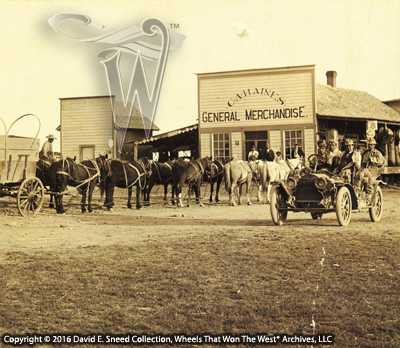We hear a lot these days about the 'transition' team that America's newest President is assembling. The process marks an event that takes place at least every 8 years and sometimes as part of a 4-year cycle - depending on the outcome of a particular election. When it comes to product innovation or industry transformations in the U.S., though, the sequence of events isn't necessarily routine or predictable. Such was the case for the massive transportation industry during the dawn of the 20th century. At the time, many in the horse-drawn era found themselves surprised at the influence and excitement heralded by the new, internal combustion machines. They couldn't fathom a total transition to motorized power and, as a result, they were largely unprepared for the change.
Overall, it's an understandable perception. With almost 200 years of this country's history being dominated by horse-drawn vehicles, a sizeable number of folks had become hard set in their ways and felt things should remain the same. Even so, it was a severely-limiting paradigm forming a lot of its own barriers to growth and success. Generations had grown up using the products and had become financially dependent on the industry. So, when a new, more advanced form of travel began to gain traction, the transformation was an unfamiliar and uneasy one for a large number of folks. It was also one that required more capital for start-ups. So, it's not all that surprising that some found it a hard proposition to warm up to. At the same time that so many were grappling with fears and resistance, others embraced and participated in the movement while still more waited to see what would happen.
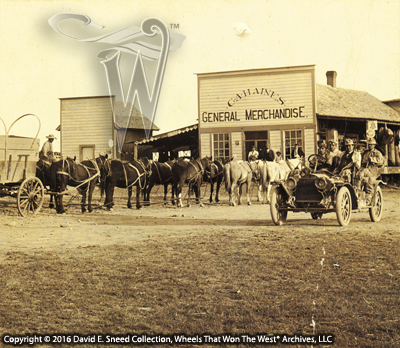
The early 1900's amounted to a collision of worlds between horse-drawn and motorized transportation.
The study of this part of our history reminds me of the old adage pointing out that there are just 3 kinds of people in this world... Those that make things happen. Those that watch what happens. And those that wonder what happened! Ultimately, those early days were a tumultuous time filled with rivalries, litigation, questions, and plenty of folks watching and wondering what the devil was going on.
During the early 1900's, there were hundreds of U.S. companies fighting for success in the newly-formed auto industry. Ultimately, almost all of them failed. Along the same lines, there were tens of thousands of horse-drawn vehicle makers and repairers struggling with their own perceptions of the horseless carriage. For some, it was a fad. For others, the vehicles were a luxury that would never be affordable. Trade publications initially decried the evils of motorized transportation. Salesmen missed no chance to deride the rubber-tired dragons whether they were gas, steam, or electric. Associations banded together to see what might be done to slow or stop the acceptance of these new-fangled machines. Articles were written discussing the noise, smell, cost, speed, power, unreliability, and other challenges associated with automobiles - some of those things continue to be a point of reference!
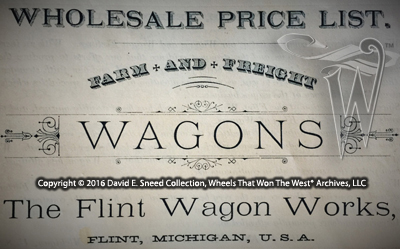
The earliest Flint wagons were adorned with scenic murals similar to those found on Concord stagecoaches. Like many legendary brands, quality Flint wagons are now among the most difficult to find.
Even so, among the ranks, there were a number of legendary wagon makers that saw true opportunity in the 'crisis' that others perceived to be a direct threat. Studebaker Bros. Manufacturing receives a fair - and deserving - amount of credit for recognizing the shifting tide.There were other wagon makers, though, that are often overlooked in their roles related to motorized transportation. Brands like Kentucky, Flint, Stoughton, Electric Wheel, Swab, Knapheide, Mitchell, Champion, and more were all active in their pursuit of various elements within the up-and-coming auto industry.
Studebaker, for instance, not only designed and crafted cars, trucks, buses, and bodies but also built aircraft engines during WWII. They had begun working on their own automobile in the late 1890's, making every effort to continually reinforce their role as a transportation king pin. After they ceased building wagons in 1920, they sold the related equipment and patterns while leasing their name to another powerful brand - the Kentucky Wagon Company of Louisville, Kentucky. This move not only gave Kentucky another strong wagon brand to sell but provided a way for Studebaker loyalists to access original parts and maintenance on wagons that had been built in South Bend.
Speaking of Kentucky (Wagon) Manufacturing Company; from their beginning in 1879, they were a force to be reckoned with. Not only were they well capitalized but they were strong marketers producing tens of thousands of wagons per year. During the 1930's, the company was even more diversified as they took charge of Continental Car Company, producing a wide array of train cars. The firm also made numerous early truck bodies and trailers, not to mention the manufacture and support of a full line of Dixie Flyer automobiles. The direct descendant of Kentucky Wagon Company - Kentucky Trailer - has not only survived but thrives as a dominant force in today's trucking, specialty trailer, and body industries. In fact, from commercial, medical, military, and government applications to motorsports, mobile broadcast production, moving and storage, package delivery, and enclosed auto haulers, Kentucky Trailer has been called, "the most innovative custom trailer manufacturer in the world."
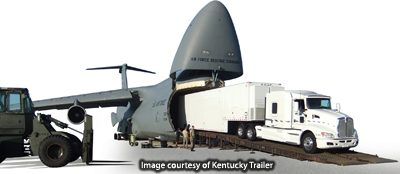
Kentucky has been a patriotic supplier to the U.S. Military for over a century.
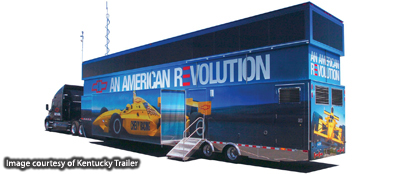
Kentucky Trailer produces a wide variety of custom work.
In Flint, Michigan where much of the 20th century auto industry eventually found a home, the owners of Flint Wagon Works also launched a plan to build cars in the first decade of the new century. This was done during the same time they were building wagons and the public was assured that they would continue manufacturing these vehicles just as they had since 1882. Ultimately, the old wagon factory served as the origin of some of the earliest Buick and Chevrolet cars.
In Elizabethville, Pennsylvania, the Swab Wagon Company is still in business with the same name it carried in the 1800's. Like many others, Swab became actively involved in building bodies for early autos. The company built their first fire-related vehicle in 1890 and, today, they specialize in the production of emergency vehicles for police, fire, and rescue needs as well as animal transports and utility bodies. With roots to 1868, the brand is still family-owned and stands as one of the country's oldest continuously-operated transportation manufacturers.
Located north of Hannibal, Missouri on the eastern bank of the Mississippi River, Quincy, Illinois is home to a pair of extraordinary survivors from the early wagon industry. One of the oldest businesses in the city today is Knapheide. Established in 1848 as Knapheide Wagon Company, the firm is well-known for its truck and van bodies, utility beds, truck caps, and tool boxes.

As evidenced by this 1891 patent, innovation and a strong quest for excellence were a big part of Titan International's DNA from the beginning.
Another of Quincy's amazing success stories has deep roots in the tire and wheel industries. Tracing its foundations to 1890, Titan International began life as the Electric Wheel Company. As such, the company was an early producer of innovative metal wheels, wagons, tractors, crawlers, truck bodies, semi-trailers, rubber tires, carts, portable motors, and numerous other products. Today, the firm is a powerful mainstay producing tires and wheels for agriculture, construction, forestry, mining, ATV, and lawn and garden applications. As such, they supply tires and wheels for many well-known brands like John Deere, Case, New Holland, Kubota, and Goodyear.
So, there they are. Just a few examples of how America's horse-drawn wagon brands worked to overcome the trials of changing times. Like so many early auto firms, most wagon builders met their demise by or during the Great Depression. Nonetheless, as we've shared in today's blog, a number of survivors have built strong foundations in the modern transportation industry. Truth is, I suspect there are more companies with roots to wagon and carriage-making still around today than those who actually started out building automobiles. It's certainly an interesting supposition that points to even greater resilience and marketing savvy than many of our country's first auto makers.
From field and farm to the highways and backroads, America's early horse-drawn brands took on an overwhelming challenge to re-make themselves with reliable and relevant offerings. It's a heritage that's been well rewarded with proven products, disciplined management, and forward-thinking momentum. Ultimately, it's no real surprise. After all, that same focus on excellence, achievement, and customer satisfaction is what drove America's first wheels to such prominence in the first place.
Please Note: As with each of our blog writings, all imagery and text is copyrighted with All Rights Reserved. The material may not be broadcast, published, rewritten, or redistributed without prior written permission from David E. Sneed, Wheels That Won The West® Archives, LLC
